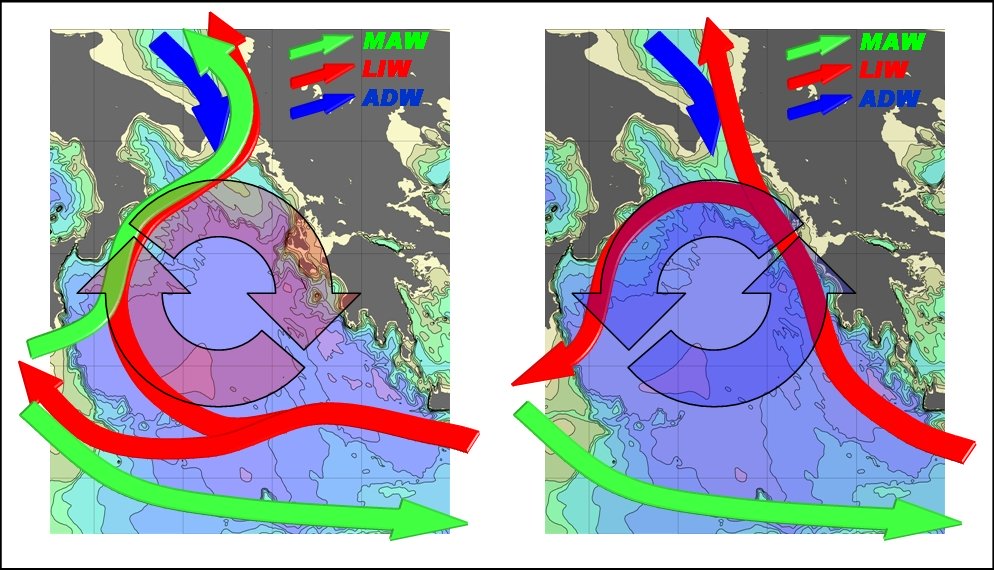Round table: Ionian surface circulation reversals and impact on deep circulation and ecosystem
Round Table
16. March at 9:00, BiO Department (via Auguste Piccard, 54 - Trieste)
Ionian surface circulation reversals and impact on deep circulation and ecosystem – Modeling and experimental approach
Preamble
Adriatic-Ionian Bimodal Oscillating System (BiOS), forced by internal dynamics, manifests as a sequence of decadal inversions of the Ionian upper-layer water circulation which passes from the cyclonic to the anticyclonic and viceversa. Temporal variations of the water circulation and thermohaline properties in a number of the Eastern Mediterraneansub-basins were shown to be attributed to BiOS.
The Adriatic decadal salinity variations have been associated with different BiOS modes resulting in a varying efficiency of the Adriatic as a dense water source. More specifically, thermohaline properties of the AdDW are determined by the presence of the saltier or fresher water imported from the Ionian in function of the circulation pattern associated with BiOS.
In terms of the salt content and the circulation pattern, it was shown that the salinity of the upper layer in the Levantine and Cretan Seas is also modulated by inversions of the Ionian water circulation pattern. In fact, the salinity in the Levantine depends on the more or less intense inflow of the fresher AW which in turn depends on the BiOS circulation mode; cyclonic BiOS mode brings in a shortest pathway the AW from the Sicily Strait to the Cretan Passage, thus resulting in a relatively low salt content in the Levantine surface waters. On the other hand, anticyclonic BiOS mode generates spreading of the AW in the Ionian interior, weakening, at the same, its inflow to the Levantine. These considerations suggest that the Eastern Mediterranean Transient (EMT) pre-conditioning can be associated with the BiOS related Ionian water circulation inversions.
Advection of different water masses into the Adriatic Sea results in changing the type of advected allochtonous organisms that may interact with the host ecosystem. Also, vertical movement of interfaces (halocline, nutricline) in the Ionian as associated with the two circulation modes, contributes to the advection of water with different biogeochemical properties towards adjacent basins. Vertical movements of interfaces may also change nutrient availability for primary production, impacting the ecosystem characteristics in the Ionian.
Number of questions remain to be addressed in future studies of BiOS and among those we would mention, not necessarily in order of importance:
- To what extent the local wind curl and the vorticity advection can modulate a sequence of inversions in the Ionian water circulation?
- How can we model BiOS?
- What are the possible scenarios of the impact of allochtonous organisms on the Adriatic ecosystem?
- Impact of BiOS on the Ionian open-sea ecosystem?
- Observational strategy for BiOS and its impacts?
- Can we say something about climate change and BiOS?
The round table will take place 16 March at 09.00 at the OGS Department BIO, Trieste, Via Auguste Piccard 54.
In the Introductory part the following invited speakers will give 20-min talks:
G. Civitarese (OGS)
M. Ribera d’Alcalà (SZN, Naples)
M. Batistić (University of Dubrovnik, Croatia)
A. Rubino (University of Venice)
S. Zecchetto (ISAC-CNR, Padova)
Invited talks will be followed by a round table discussion moderated by:
M. Gačić, G. Civitarese, G. Borzelli
Lunch break: 12.30-14.00
Closure time: 17.00

